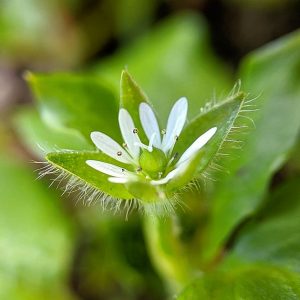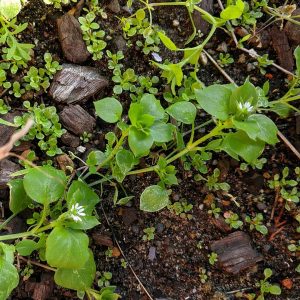Common Chickweed (Stellaria media), an annual Eurasian microgreen, herbal remedy and fresh chickenfeed.
Stellarias can be distinguished from the related Cerastiums—the Mouse-eared Chickweeds—by the shape of their leaves, by their complement of three styles (to five in Cerastium) and by their five deeply divided petals (Cerastium petals are shallowly cleft). Stellaria media can be identified within the genus by the single row of white hairs running down just one side of the stem.
Common Chickweed has been widely distributed across the extra-tropical world with European agricultural methods and imports of seeds, plants and materials. It was recorded formally in Tasmania and QLD in 1875, however it had already been reported as ubiquitous in Joseph Hooker’s 1859 Flora of Australia.
In fact, the plant arrived so quickly and was so immediately ubiquitous that many English settlers, even those with botanical training, took it to be indigenous. This was, for instance, the position taken by F.M. Bailey, later to be the Government Botanist in Queensland, in an 1879 paper to the Linnaean Society, listing it among 13 species that ‘it is somewhat doubtful whether [they] may not really be indigenous.’ By the time Bailey published his 1899 Queensland Flora, he seems to have accepted the plant’s introduced status, or at least dropped it as a subject of consideration, reproducing George Bentham’s treatment from the 1860s-1870s Flora Australiensis that the species ‘originated, probably, in the temperate regions of the northern hemisphere in the Old World.’
Although we are barely inside its flowering window, it already feels like the height of Chickweed season here in weedy Melbourne, with every bit of damp and damaged ground burgeoning with this green micro-army.
View Original Post on Instagram
Search for information about Stellaria media in the Flora of Victoria
View information and occurrences of Stellaria media on the Atlas of Living Australia









